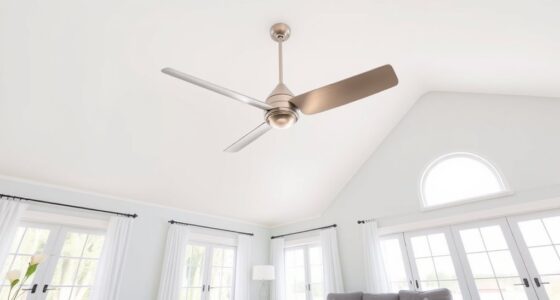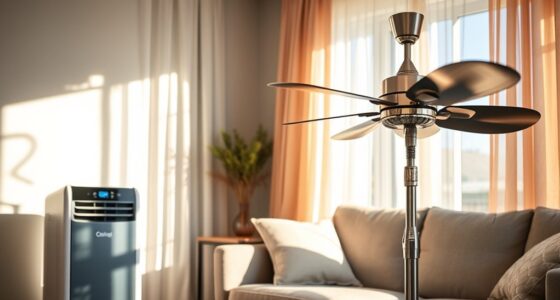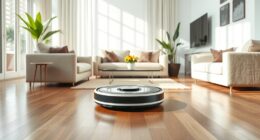Ceiling fans use markedly less energy than air conditioners, typically consuming less than 100 watts compared to 1,500 watts for AC units. Fans create a cooling sensation by circulating air, which helps you feel cooler without lowering the actual temperature, making them more energy-efficient for moderate weather. If you want to save money and reduce your environmental impact, using fans wisely can make a big difference—more details reveal how to maximize your savings.
Key Takeaways
- Ceiling fans consume 40-75 watts, significantly less than air conditioners, which use 750-1500 watts or more.
- Fans are 7 to 16 times more energy-efficient seasonally than air conditioning systems.
- Using fans with higher thermostat settings can reduce overall cooling energy consumption.
- Fans produce fewer greenhouse gases and have a smaller carbon footprint compared to air conditioners.
- Running a fan all day costs less than 1% of the energy needed for a short period of AC operation.
Energy Efficiency and Power Consumption Comparison
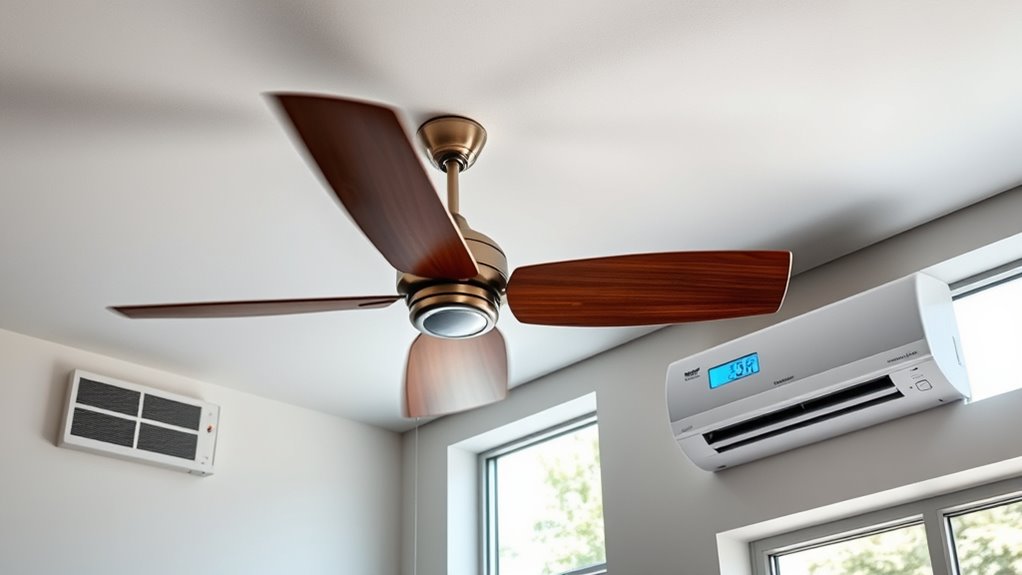
When comparing energy efficiency and power consumption, ceiling fans clearly outperform air conditioners. They can be 7 to 16 times more efficient seasonally, especially when using DC motors with electronic speed controls, which optimize energy use. A typical ceiling fan consumes just 40 to 75 watts, while an air conditioner uses 750 to 1500 watts—sometimes even more. This means a fan uses about 1% of the electricity that an air conditioner does under similar conditions. Running a fan all day consumes less energy than running an air conditioner for just 15 minutes. Fans circulate air to create a cooling sensation without lowering the room temperature, making them a much more energy-efficient choice for maintaining comfort. Additionally, projector technology advancements have led to more energy-efficient models that consume less power while delivering high-quality images.
Functional Differences and Impact on Energy Use

Ceiling fans and air conditioners serve different functions, which directly impact their energy use. Fans circulate air to create a cooling sensation without changing the actual room temperature, relying on evaporation to make you feel cooler. They don’t lower humidity or temperature but can make you perceive a 5°F cooler environment. Techniques like layering can be used to create more realistic sound effects that mimic the ambient sounds of different climates, enhancing the authenticity of a scene. Air conditioners actively remove heat and humidity, lowering indoor temperature and moisture levels, which requires more energy. Because fans help distribute air evenly and boost comfort, they can allow you to raise the thermostat setting, reducing AC energy consumption. While fans alone aren’t suitable for hot, humid climates, combining them with an AC can improve efficiency and decrease overall energy use. Their distinct functions mean they impact your energy bill and comfort differently. Fans are significantly more energy-efficient(https://example.com/energy-efficiency) than air conditioners, consuming less power for comparable cooling effects.
Environmental Effects and Sustainability Considerations

Have you ever considered how ceiling fans and air conditioners differ in their environmental impacts? Ceiling fans use much less electricity—between 10 to 100 watts—compared to air conditioners’ 1,000 to 3,500 watts. This lower energy use results in fewer greenhouse gases and a smaller carbon footprint. Additionally, ceiling fans with DC motors and integrated LEDs further reduce environmental impact. Many are made from eco-friendly materials and meet standards like Energy Star, supporting sustainability and green building certifications. They also improve indoor air quality by promoting air circulation without recirculating pollutants. Here’s a quick comparison:
| Feature | Ceiling Fans | Air Conditioners | Impact |
|---|---|---|---|
| Energy Consumption | 10-100W | 1,000-3,500W | Lower for fans, less emissions |
| Material Sustainability | Eco-friendly, LED lighting | Less focus on eco-materials | Fans support sustainable manufacturing |
| Maintenance & Waste | Longer lifespan, simpler recycling | Shorter lifespan, more waste | Fans produce less electronic waste |
Furthermore, choosing energy-efficient designs can significantly enhance their environmental benefits.
Cost Implications and Long-Term Savings
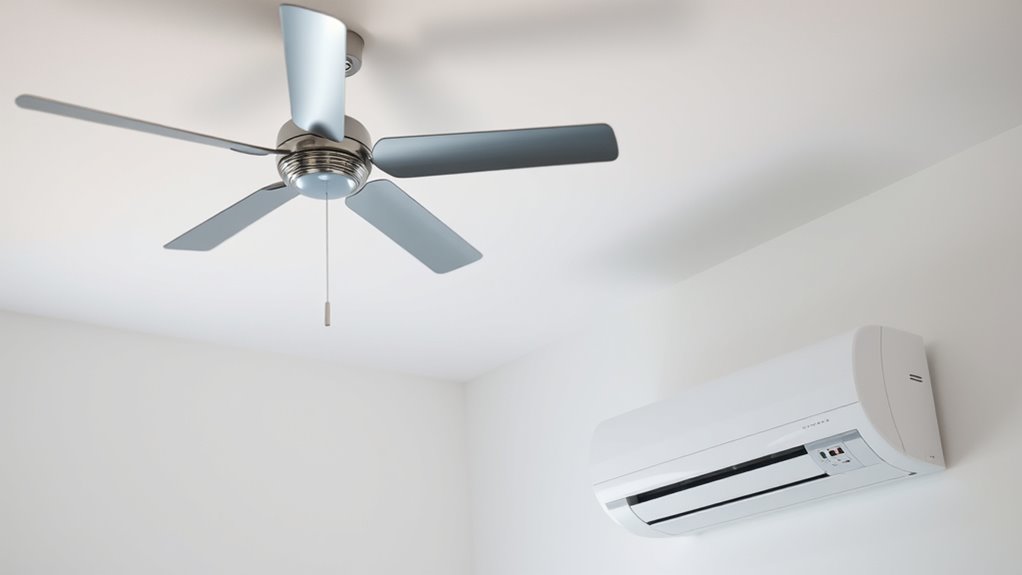
Opting for ceiling fans over air conditioners can lead to significant long-term savings due to their lower operational costs. Fans typically use around 75 watts or less, costing less than a cent per hour, while AC units can consume 429 to 1,500 watts, costing over 30 times more. Their lower energy consumption results in smaller monthly utility bills. Maintenance for fans is simple and inexpensive, mainly requiring occasional cleaning, whereas ACs need more costly repairs like refrigerant recharging. Additionally, newer DC motor fans last longer and are more efficient, further reducing costs. Using fans during moderate weather lessens reliance on AC, extending its lifespan and saving money. Modern fans with LED lighting and smart features also contribute to energy savings and convenience. Incorporating energy-efficient technology into fans enhances their savings potential. Overall, the initial investment in fans is lower, and their ongoing energy and maintenance costs make them a more economical long-term choice.
Strategic Usage Tips for Optimal Energy Conservation
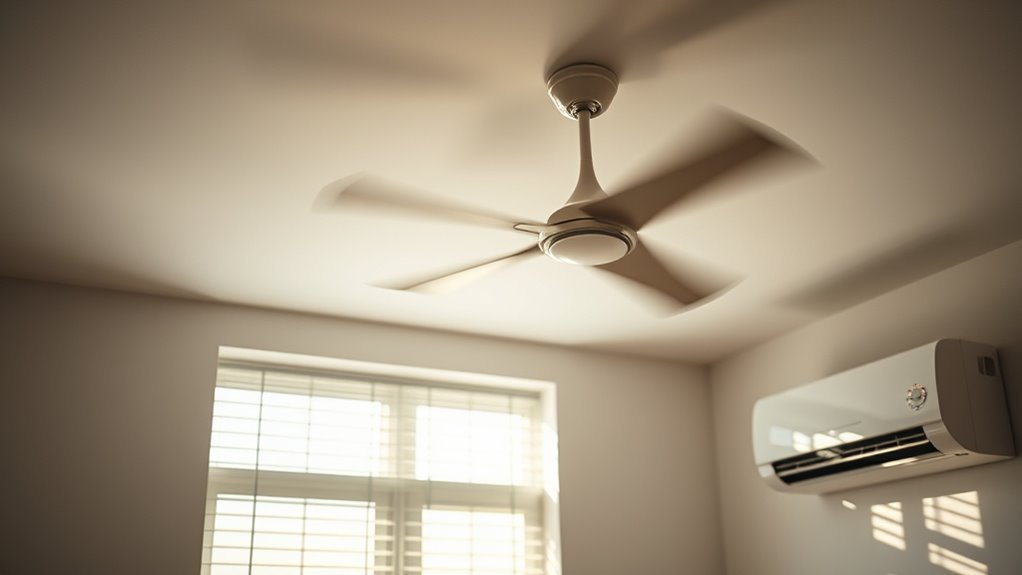
To maximize energy savings with ceiling fans, it’s important to use them strategically in conjunction with your thermostat settings. Raise your thermostat by at least 2°F when running fans to achieve about 14% net cooling energy savings, considering fan electricity use. Avoid small adjustments like 0.5°F, which can waste energy if not paired with proper fan use. Turn fans off in unoccupied rooms to prevent unnecessary energy consumption, as they cool people, not spaces. Use fans during milder heat periods and switch to air conditioning during extreme temperatures. Adjust fan speeds based on occupancy and comfort needs, and only operate fans when rooms are occupied. Ceiling fans use significantly less energy than air conditioners, making them an efficient cooling option. Combining these strategies helps you optimize energy use and reduce costs effectively. Additionally, understanding how energy consumption varies between appliances can help you make more informed decisions to enhance overall efficiency.
Frequently Asked Questions
How Does Room Size Affect the Energy Efficiency of Fans Versus Air Conditioners?
Room size substantially impacts your choice between fans and air conditioners. For small rooms, fans are much more energy-efficient, using far less power and providing sufficient comfort through airflow. In larger spaces, ACs become more necessary for effective temperature and humidity control, despite higher energy use. Using fans in medium-sized rooms can help reduce AC energy consumption, saving you money while maintaining comfort.
Can Using a Fan Alone Meet Cooling Needs in Extreme Heat Conditions?
Using a fan alone in extreme heat usually isn’t enough to meet your cooling needs. Fans circulate air and create a wind-chill effect, but they don’t lower the room temperature or remove humidity. When it’s scorching outside, fans can even make you feel hotter if there’s no sweat evaporation. For real relief during extreme heat, you need an air conditioner or other cooling methods, not just a fan.
How Often Should Ceiling Fans and Air Conditioners Be Maintained for Optimal Efficiency?
Maintaining your fans and ACs maximizes their magic, minimizing mishaps and maximizing efficiency. You should clean ceiling fans every 2-3 months, especially in dusty or pet-friendly homes, and inspect them annually. For air conditioners, plan professional checkups twice a year, with monthly filter changes. Regular repairs and routine reviews keep cooling costs low and comfort high, ensuring your systems serve you smoothly season after season.
Do Different Fan Blade Materials Impact Energy Consumption?
Different fan blade materials directly impact your energy use. Light-weight plastic or composite blades reduce motor load, making the fan operate more efficiently and consume less electricity. Metal blades are more durable and efficient for large spaces but may increase energy consumption if heavy or poorly balanced. Choosing aerodynamic, properly balanced blades made of lightweight materials helps you save energy, ensuring quieter operation and longer motor life.
What Are the Best Practices to Combine Fans and Air Conditioners for Energy Savings?
To save energy, you should use fans with your AC wisely. Turn on ceiling fans before or during AC operation to increase airflow and comfort. Set the thermostat higher by about 4°F when fans are running, reducing AC workload. Keep fans off when rooms are unoccupied, and choose energy-efficient models with DC motors. Synchronize fan and AC use during peak heat, and educate occupants to maximize these strategies effectively.
Conclusion
If you’re aiming to cut energy costs, ceiling fans typically use about 90% less electricity than air conditioners. For instance, a ceiling fan consumes just 50 watts, while a central AC can use over 2000 watts. By choosing fans when possible, you could save hundreds annually. So, consider strategic use—fans for cooling, AC for extreme heat—and enjoy lower bills and a greener footprint. Small changes make a big difference!


